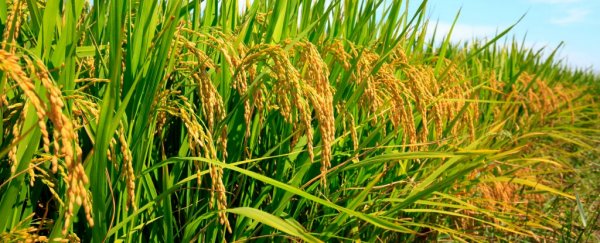Human-caused greenhouse gas emissions threaten to make rice less nutritious, scientists said in a study released Wednesday, raising a worrying possibility about the staple food item for billions of humans.
Rice, the scientists found, contains lower levels of key vitamins when grown amid high concentrations of carbon dioxide, the most common of the greenhouse gases driving climate change.
"If we do nothing, then yes, there is this potential for profound negative impacts on human health," said Kristie Ebi, a public health researcher at the University of Washington in Seattle and one of the authors of the study, which also involved researchers at institutions in China, Japan, Australia and the United States, including at the US Agriculture Department.
The research, conducted in Japan and China, examined 18 rice varieties in outdoor experiments in which the plants were subjected to atmospheric carbon dioxide concentrations of 568 to 590 parts per million.
Current concentrations are about 410 parts per million, but they're growing at about 2 parts per million every year - and could reach the study's levels in the later part of this century.
Rice accounts for "approximately 25 percent of all global calories," according to the study, which was published in the journal Science Advances. It was led by Chunwu Zhu of the Chinese Academy of Sciences.
The study found that at the high concentrations, the crop's content of the vitamins B1, B2, B5 and B9 all declined, including by as much as 30 percent for B9 (folate).
The research also confirmed previously discovered declines in protein, iron and zinc.
"There's been studies over the past hundred years for the importance of these B vitamins," Ebi said.
"One that declines with higher CO2 concentrations is folate. And we know that folate deficiencies in pregnant women can result in children that have various birth anomalies. So they're critically important, particularly for maternal and child health, but for all of us."
It pairs up with recent research also suggesting that another major global staple crop, wheat, could see lower yields as the planet warms.
The consequences for wheat are tied to rising temperatures, but with rice, the immediate issue appears to be the growing concentrations of carbon dioxide in the atmosphere.
Plants pull carbon from the air and grow, and they will pull more of it as concentrations rise.
The problem is that other aspects of their metabolism may not keep pace, meaning that they would draw in less nutrients from soils as they grow, and proportionately more carbon.
It's the change in this makeup of the plant itself that could, in turn, translate into changes in its nutritional content for those who consume it.
"CO2 is plant food in the sense that it makes plants grow more," said Lewis Ziska, another study author with the Department of Agriculture.
"But often when plants grow more, that doesn't necessarily mean that you get the same quality of the plant."
Because of this, Ebi and Ziska said, rice could in fact already be losing some of its nutritional content under current atmospheric carbon dioxide concentrations - but the research has not been done at this point to confirm that.
It could require comparing today's rice to rice from decades ago, which would mean using samples that have been preserved somehow.
And it isn't just rice. The basic mechanism here could involve other plants and other food staples, said Chuck Rice, a professor of Agronomy at Kansas State University who commented on the study for the Post.
"I haven't seen anything about the vitamins, that was new in this paper," Rice said, "but there's other reports that show, or ate least model and have done some lab estimates, that anywhere from 2 to 10 percent less protein content for grains under [an] elevated CO2 environment."
Rice said results like these could greatly undermine attempts to improve global nutrition.
"I'm here in Columbia, they're working on biofortified legumes, beans and rice…for micronutrient deficiencies, iron, zinc, and particularly for places like Africa or Asia," he said.
"And what this does is just almost negate some of those gains that we're trying to make for deficiencies in the population that's being most harmed unfortunately."
Indeed, the research fits an increasingly common theme in climate findings, which is that the poor and disadvantaged globally would be hit hardest by these kinds of changes, and would be least able to adjust or diversify their diets in order to pick up nutrients in other ways.
"When you think about who consumes as a proportion of their diet the most starch, it generally is the poor, in all countries," Ebi said.
2018 © The Washington Post
This article was originally published by The Washington Post.
